Global 5G IOT Market - Comprehensive Data-Driven Market Analysis & Strategic Outlook
The global 5G IOT market in the telecom and technology industry will keep on redefining how devices connect, interact, and function across industries. The evolution starts from the early cellular network trials and machine-to-machine communication that progressed to form the foundation for communicating everyday objects beyond regular computing devices. The market was primarily trial-based in the early phase with industrial clients piloting sensor networks, smart grids, and remote monitoring. The first tipping point came with the rollout of 4G networks with more reliable mobile connectivity, which triggered the use of IoT devices in consumer and industrial settings early on.
- Global 5G IOT market value of around USD 24.4 Billion as of 2025, increasing at a CAGR of around 35.0% through 2032, with a possibility of reaching over USD 199.6 Billion.
- 5G Standalone represented about 39.3% of the market share, encouraging diversity and innovation in applications by engaging in rigorous research.
- Key trends driving growth: Surge in connected devices and ultra-low latency applications across healthcare, automotive, and industrial sectors
- Opportunities include: Rising demand for private 5G networks in manufacturing and enterprise environments
- Key insight: The market is set to grow exponentially in value over the next decade, highlighting significant growth opportunities.
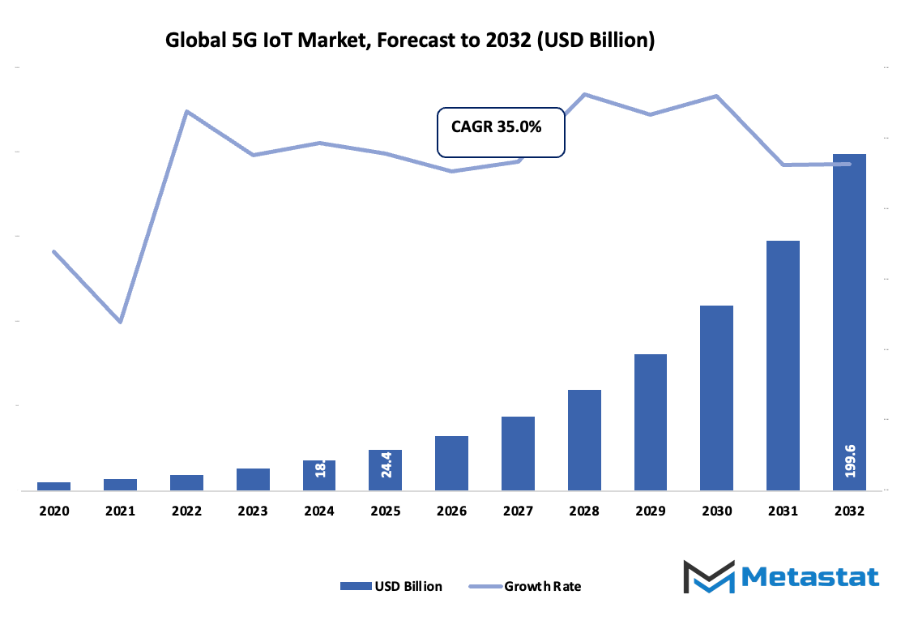
As there is a growing requirement for quicker data communication and immediate response, the global 5G IOT market consistently acquired prominence of technology companies, telecommunication operators, as well as government departments.
Early showcase was in smart cities, self-driving cars, and health monitoring systems, demonstrating the potential of networked devices to raise efficiency, security, and service delivery. Regulation systems evolved with them, imposing requirements on spectrum sharing, data protection, and device interoperability, that fostered trust and prepared the ground for mass take-up. There will be continued technological innovation in the marketplace. Network slicing, edge computing, and ultra-low latency communications will enable even more sophisticated applications, from remote surgery to industrial automation. Consumers will demand ever-more seamless, connected experiences, pushing device makers and service providers to innovate around the clock. The marriage of AI-driven analytics and 5G connectivity will enable predictive maintenance, personalized services, and real-time decision-making across industries, leading the direction of the market in ways only previously imagined. In the next few years, the 5G IOT market globally will go far beyond conventional devices to insinuate itself in transport networks, energy management networks, and environmental monitoring networks.
Mass implementation will be facilitated by partnerships among the telecommunications providers, technology firms, and government agencies, and policy changes and security measures will ensure assurance of scalability and reliability.
The process of growth from proof-of-concept networks to fully integrated smart systems is the path followed by the global 5G IOT market, and the next ten years will witness it becoming an integral part of digital life all over the globe.
Market Segments
The global 5G IOT market is mainly classified based on Network Type, IoT Connectivity, Vertical.
By Network Type is further segmented into:
- 5G Standalone: The 5G Standalone networks will dominate the global 5G IOT market with more speed, reduced latency, and higher reliability of connectivity. IoT devices would be independent of the help of 4G infrastructure. The deployments of Standalone networks will enhance high-end applications, like real-time analytics and autonomous operations, to develop intelligent connected systems.
- 5G Non-standalone: The global 5G IOT market will grow via 5G Non-standalone networks, which leverage current 4G infrastructure to introduce 5G functionality. These networks will also serve as an intermediary to provide greater connectivity and IoT rollout. Non-standalone solutions will increasingly be adopted by cities and businesses as they improve efficiency even before they are fully established to be implemented standalone.
By IoT Connectivity the market is divided into:
- Sub-Massive IoT: The global 5G IOT market will experience the rise of Sub-Massive IoT, which will support an enormous amount of devices with minimal data requirements. Sub-Massive IoT will enable the best possible performance of smart home appliances, wearables, and small-scale sensors. Next-generation networks will realize maximum energy efficiency and device control for achieving scalable and sustainable growth.
- Broadband IoT: Broadband IoT will take over the global 5G IOT market with faster connectivity for those devices that need large data transfer. This will allow real-time video surveillance, high-definition sensors, and interactive services. Additional bandwidth on a permanent basis will make IoT systems responsive and able to carry out complex data-based processes.
- Critical IoT: The global 5G IOT market will increase internationally with the assistance of Critical IoT, which will enable ultra-reliable and low-latency communication for mission-critical application use cases. The connections will be applied in response emergency systems, industrial protection systems, and self-driving control systems. Greater usage of Critical IoT in safety, security, and precision environments will be observed in the coming years.
- Industrial Automation IoT: Industrial Automation IoT will lead the global 5G IOT market by offering real-time monitoring and predictive maintenance for production factories. The machines will converse with one another easily, reducing downtime and increasing productivity. Production factories will enjoy intelligent automation systems based on 5G connectivity that will enhance industrial processes and make manufacturing more competitive globally.
By Vertical the market is further divided into:
- Manufacturing: The global 5G IOT market will transform manufacturing into smart factories with smart machines, robots, and maintenance prediction. Production will be optimized through data analysis, increase quality, and reduce costs. Factories will be intelligent response systems to react to rising demand while being efficient and accurate.
- Smart Cities: The global 5G IOT market will drive smart city initiatives like traffic management, waste management, and energy efficiency. Urban living will be made more convenient by networked infrastructure in terms of enhanced security, resource management, and public services. Cities of the future will be built on 5G-backed IoT platforms to make cities cleaner, greener, and efficient.
- Energy & Utilities: The global 5G IOT market will enhance energy and utility management through grid monitoring, failure forecasting, and resource utilization optimization. Sensors based on IoT will provide real-time data for the harmonic integration of renewable energy and optimal power distribution. Cost-saving smart systems with enhanced reliability and sustainability will be welcomed by utilities.
- Transportation & Logistics: The global 5G IOT market will revolutionize transportation and logistics with real-time tracking, fleet management, and intelligent maintenance. Carriers, warehouses, and supply chains will be efficient, connected, and transparent. 5G IoT will serve as the foundation of future-proof logistics networks to optimize routes, reduce delays, and enhance safety.
- Enterprises/Corporates: The global 5G IOT market will transform corporate businesses by making smart offices, secure networks, and real-time collaboration tools a reality. IoT data will be utilized by companies to maximize productivity, customer interaction, and decision-making. The corporate sector will witness a new era of data-driven strategies based on converged 5G connectivity among devices.
- Healthcare: The global 5G IOT market will revolutionize healthcare with telemedicine, remote monitoring, and internet-enabled medical devices. Real-time patient data will improve analysis and treatment efficiency. Clinics and hospitals will increasingly rely on IoT systems driven by 5G to propel patient care, reduce errors, and streamline procedures in a highly networked healthcare sector.
- Others: The global 5G IOT market will also have an impact on other sectors such as agriculture, retail, and entertainment through intelligent solutions and real-time processing. Agriculture will benefit from precision farming, smart inventory control, and engaging experiences with secure 5G connectivity. New applications will keep growing as growing technology adoption widens across industries.
|
Forecast Period |
2025-2032 |
|
Market Size in 2025 |
$24.4 Billion |
|
Market Size by 2032 |
$199.6 Billion |
|
Growth Rate from 2025 to 2032 |
35.0% |
|
Base Year |
2024 |
|
Regions Covered |
North America, Europe, Asia-Pacific, South America, Middle East & Africa |
By Region:
- Based on geography, the global 5G IOT market is divided into North America, Europe, Asia-Pacific, South America, and the Middle East & Africa.
- North America is further divided into the U.S., Canada, and Mexico, whereas Europe consists of the UK, Germany, France, Italy, and the Rest of Europe.
- Asia-Pacific is segmented into India, China, Japan, South Korea, and the Rest of Asia-Pacific.
- The South America region includes Brazil, Argentina, and the Rest of South America, while the Middle East & Africa is categorized into GCC Countries, Egypt, South Africa, and the Rest of the Middle East & Africa.
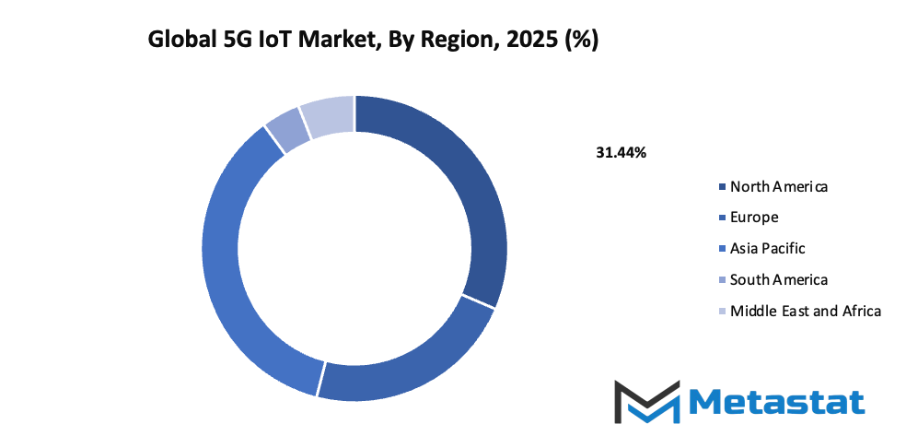
Growth Drivers
- Rapid expansion of smart city and Industry 4.0 initiatives fueling demand for high-speed low-latency connectivity: The global 5G IOT market will experience rapid progress due to the expansion of smart city projects and Industry 4.0 developments. Smart cities will depend on advanced networks to handle massive data flow from sensors, surveillance systems, and automated services. Industry 4.0 will depend on reliable and low-latency communication to connect intelligent machines, robots, and production lines. This combination of urban transformation and industrial automation will create steady demand for strong 5G-based IoT networks capable of real-time communication and efficient operation management. The integration of these technologies will reshape both city infrastructure and industrial processes by improving productivity, energy efficiency, and public services.
- Surge in connected devices and ultra-low latency applications across healthcare, automotive, and industrial sector:
The global 5G IOT market will benefit greatly from the growing number of connected devices that require ultra-low latency performance. In healthcare, 5G-enabled IoT devices will support remote surgeries, continuous patient monitoring, and real-time diagnostics. The automotive sector will rely on 5G connectivity for autonomous driving, vehicle-to-everything communication, and enhanced safety features. Industrial sectors will adopt it to enable smart factories, predictive maintenance, and automation of critical operations. These advancements will lead to a more efficient and connected environment, ensuring that devices and systems operate seamlessly without delays or data interruptions.
Challenges and Opportunities
- High infrastructure investment and deployment costs slowing 5G network rollout: The development of the global 5G IOT market will face challenges due to the high cost of infrastructure and deployment. Establishing a widespread 5G network will require significant investment in new base stations, fiber connections, and advanced equipment. Many regions, particularly in developing economies, may struggle to allocate funds for such large-scale projects. This financial burden may delay network expansion and slow the adoption of IoT solutions that depend on 5G connectivity. However, partnerships between governments, private companies, and telecom providers may gradually ease these limitations through shared funding and resource optimization.
- Security and interoperability challenges limiting adoption across industries:
Security and interoperability will remain key concerns for the global 5G IOT market. As billions of devices connect to 5G networks, the risk of cyberattacks and data breaches will increase. Maintaining data privacy, device authentication, and secure communication channels will be essential. Moreover, the lack of universal standards for IoT devices will cause compatibility issues between manufacturers and systems. These challenges could slow industrial adoption, as companies will seek reliable and secure solutions before full-scale implementation. Addressing these issues through standardized protocols and strong cybersecurity frameworks will be vital for widespread market acceptance.
Opportunities
- Rising demand for private 5G networks in manufacturing and enterprise environments: The global 5G IOT market will gain new opportunities from the increasing demand for private 5G networks. Manufacturing facilities and enterprise environments will seek dedicated 5G networks to improve control, reliability, and security of operations. Private networks will allow companies to tailor connectivity according to specific needs such as automation, machine communication, and data protection. These customized systems will enhance productivity, reduce downtime, and support flexible production models. As industries aim to achieve higher efficiency and innovation, private 5G networks will become a crucial component of future industrial and business transformation.
Competitive Landscape & Strategic Insights
The global 5G IOT market will continue to grow rapidly, driven by advancements in network infrastructure, increasing demand for connected devices, and expanding applications across industries. The industry is a mix of both international industry leaders and emerging regional competitors. Important competitors include Qualcomm Technologies, Inc., Ericsson, Nokia Corporation, Semtech Corporation, Samsung Electronics Co., Ltd., Intel Corporation, Cisco Systems, Inc., AT&T Inc., Verizon Communications Inc., Vodafone Group Plc, Telefonica S.A., BT Group Plc, ZTE Corporation, NEC Corporation, Tri Cascade Inc., Deutsche Telekom AG, Hewlett Packard Enterprise, China Mobile Ltd., LG Electronics Inc., Sony Corporation, and Celona. These companies play a critical role in shaping the technological standards, creating innovative solutions, and meeting the growing connectivity demands across different sectors.
The future of the 5G IOT market will be shaped by the integration of advanced technologies such as artificial intelligence, edge computing, and smart sensors, which will improve efficiency, enhance data processing capabilities, and enable more responsive network solutions. International leaders like Qualcomm and Ericsson will continue to drive innovation, setting benchmarks for high-speed connectivity and secure networks, while regional competitors will focus on tailored solutions to meet local market requirements. Emerging players will push the industry forward by exploring niche applications, experimenting with new business models, and providing cost-effective technologies that can be rapidly deployed.
Investments in infrastructure, collaborative partnerships, and research initiatives will accelerate the adoption of 5G IOT technologies worldwide. Companies like Samsung, Intel, and Cisco will develop solutions to support smart cities, industrial automation, and intelligent transportation systems, while telecom operators including AT&T, Verizon, and Vodafone will expand network coverage to connect urban and rural regions more efficiently. Additionally, collaboration between established global players and regional innovators will create opportunities for scalable, flexible solutions capable of addressing diverse market needs.
Looking ahead, the industry will not only focus on connecting devices but also on enabling real-time analytics, predictive maintenance, and energy-efficient operations. As 5G IOT adoption grows, these solutions will redefine how businesses operate, how cities manage resources, and how individuals interact with technology. Companies such as Nokia, ZTE, and NEC will contribute to developing standards and security protocols, ensuring that future networks are robust, reliable, and adaptable to evolving demands. The market will also see the emergence of smaller specialized players like Tri Cascade Inc. and Celona, who will provide innovative solutions for private networks and localized IoT ecosystems.
Market size is forecast to rise from USD 24.4 Billion in 2025 to over USD 199.6 Billion by 2032. 5G IOT will maintain dominance but face growing competition from emerging formats.
In conclusion, the global 5G IOT market will become increasingly dynamic, driven by a combination of innovation from leading international companies and the agility of regional competitors. Collaboration, investment in technology, and the pursuit of advanced network solutions will enable this market to expand, creating a connected future where smart devices, intelligent systems, and advanced communication networks seamlessly work together. This ongoing evolution will redefine technological possibilities, economic opportunities, and everyday life across the world.
Report Coverage
This research report categorizes the global 5G IOT market based on various segments and regions, forecasts revenue growth, and analyzes trends in each submarket. The report analyses the key growth drivers, opportunities, and challenges influencing the global 5G IOT market. Recent market developments and competitive strategies such as expansion, type launch, development, partnership, merger, and acquisition have been included to draw the competitive landscape in the market. The report strategically identifies and profiles the key market players and analyses their core competencies in each sub-segment of the global 5G IOT market.
5G IOT Market Key Segments:
By Network Type
- 5G Standalone
- 5G Non-standalone
By IoT Connectivity
- Sub-Massive IoT
- Broadband IoT
- Critical IoT
- Industrial Automation IoT
By Vertical
- Manufacturing
- Smart Cities
- Energy & Utilities
- Transportation & Logistics
- Enterprises/Corporates
- Healthcare
- Others
Key Global 5G IOT Industry Players
- Qualcomm Technologies, Inc.
- Ericsson
- Nokia Corporation
- Semtech Corporation
- Samsung Electronics Co., Ltd.
- Intel Corporation
- Cisco Systems, Inc.
- AT&T Inc.
- Verizon Communications Inc.
- Vodafone Group Plc
- Telefonica S.A.
- BT Group Plc
- ZTE Corporation
- NEC Corporation
- Tri Cascade Inc.
- Deutsche Telekom AG
- Hewlett Packard Enterprise
- China Mobile Ltd.
- LG Electronics Inc.
- Sony Corporation
- Celona
WHAT REPORT PROVIDES
- Full in-depth analysis of the parent Industry
- Important changes in market and its dynamics
- Segmentation details of the market
- Former, on-going, and projected market analysis in terms of volume and value
- Assessment of niche industry developments
- Market share analysis
- Key strategies of major players
- Emerging segments and regional growth potential



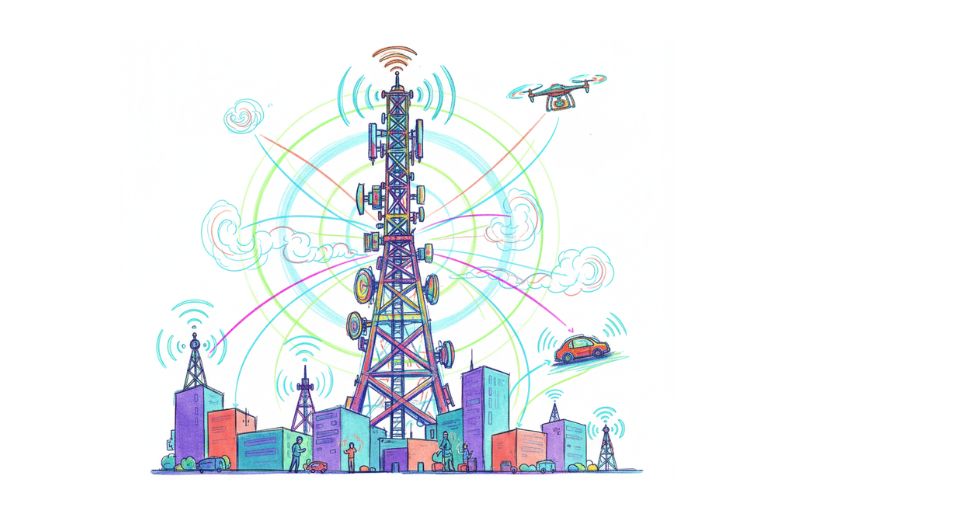
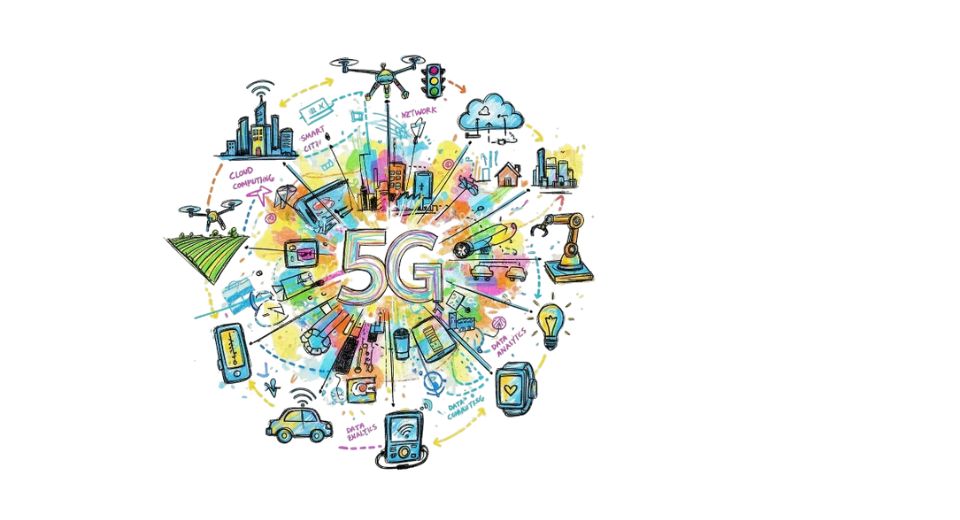

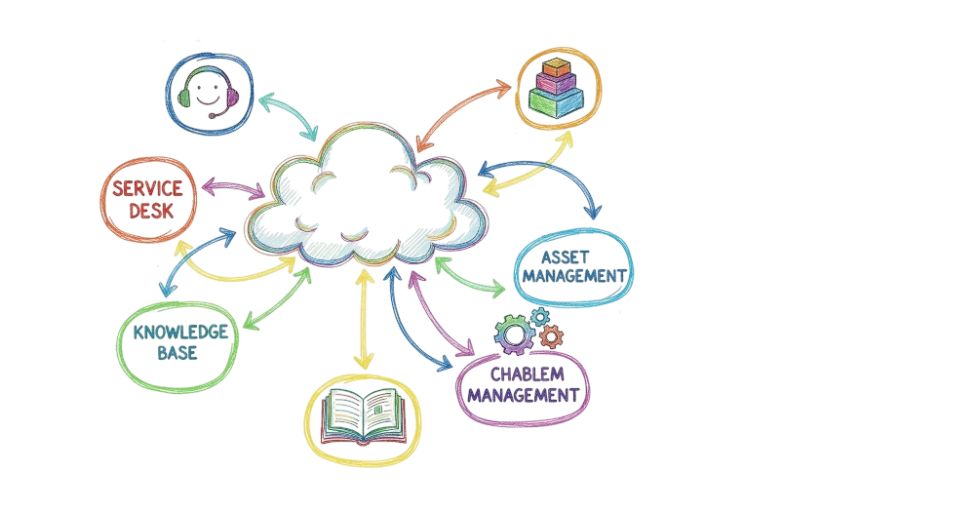

 US: +1 3023308252
US: +1 3023308252






